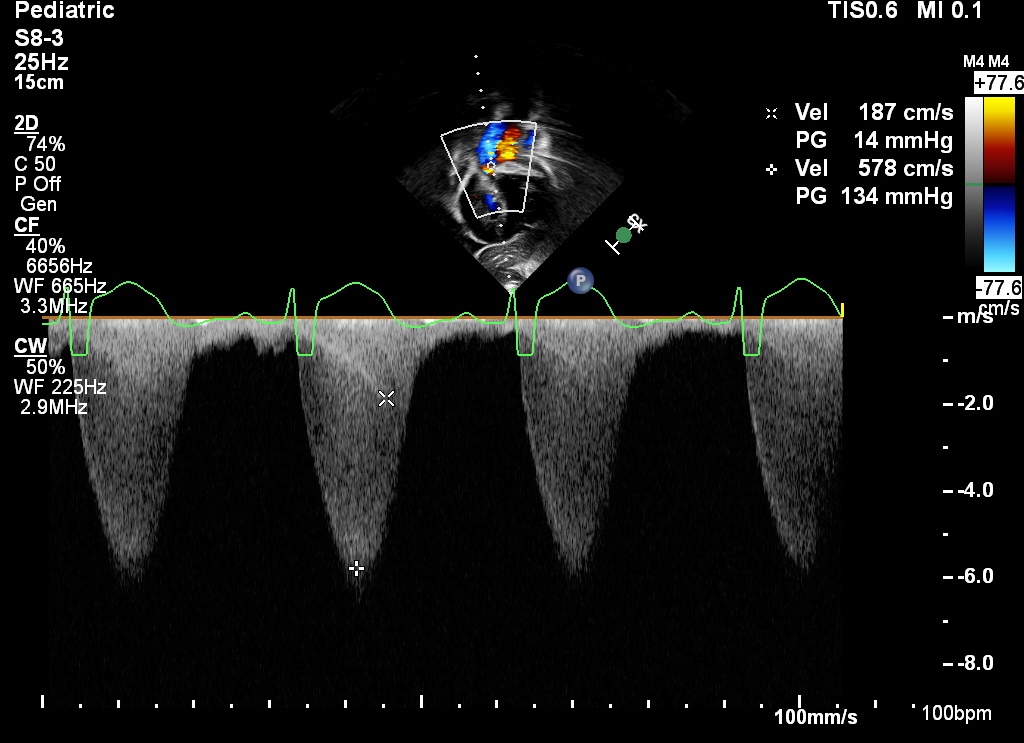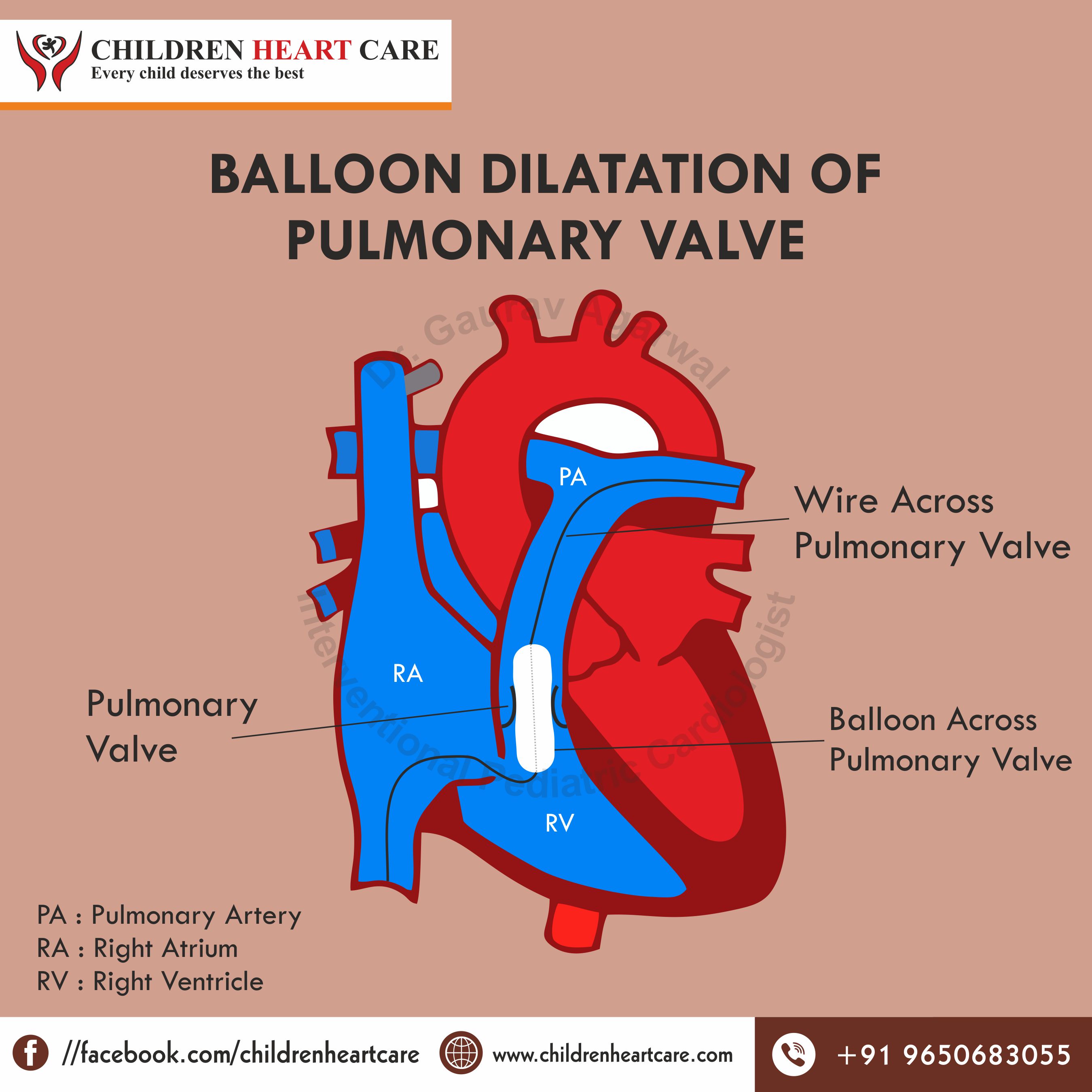Common Cardiac Conditions
- ASD Surgery in Delhi
- VSD Surgery in Children in Delhi
- Best PDA Surgery in Delhi
- Coarctation of Aorta Treatment in Delhi
- Aortic Stenosis Treatment in Delhi
- Pulmonary Stenosis
- Atrio-Ventricular Septal Defect (AVSD/AVCD)
- RSOV Treatment in Delhi
- Eisenmenger Syndrome/ Complex
- Tetralogy of Fallot Treatment
- Transposition of Great Arteries (d-TGA)
- Total anomalous pulmonary venous connection treatment in Delhi
- Truncus Arteriosus
- Tricuspid Atresia
- Double Outlet Ventricle
- Congenitally Corrected Transposition of great vessels in Delhi
- Ebstein’s Anomaly
- Pulmonart Atresia (PA) Without VSD/Intact Septum
- Pulmonart Atresia (PA) with VSD
- Hypoplastic Left Heart Syndrome
- Stenosis of Pulmonary Artery Branches
- Patent Foramen Ovale (PFO)
- AP Window Device Closure
- Vascular Rings
- Interrupted Aortic Arch (IAA)
- Bicuspid Aortic Valve Treatment
- SVT treatment in children
PULMONARY STENOSIS IN CHILDREN
- If the blood flow between right ventricle (right sided lower chamber of the heart) and pulmonary artery (blood vessel arises from the heart and supplies impure blood to the lungs for blood purification) is blocked, it is known as Pulmonary Stenosis (PS).
- This is a congenital heart defect (CHD).
- Pulmonary stenosis can occur in newborn, infants, children and adolescents and even in adults.
- Pulmonary artery is having a valve at its origin that is known as pulmonary valve.
- Blockage can occur at the level of valve, below the level of valve or above the level of valve, it is known as valvular, subvalvular or supravalvular pulmonary stenosis respectively.
- Pulmonary valves regulate blood flow to the lungs.
- When pulmonary valve opens, it allows blood to go forward then it closed down so that blood will not come back to right sided ventricle.
- However, if there is a problem with the pulmonary valve or above or below this valve, it cannot open entirely and that restricts the passage of blood into pulmonary artery. The heart has to work extra hard to ensure that the entire volume of blood flow through the faulty valve or right ventricle outflow tract.
- Most commonly pulmonary valve leaflets are thickened and fused in cases of pulmonary valve stenosis, these lead to less mobile leaflets of pulmonary valve, which leads to blockage of the valve. Occasionally, valve leaflets are small in size which leads to obstruction of the valve “(Congenital pulmonary stenosis)”.
Pulmonary stenosis is very commonly associated with cyanotic congenital heart diseases known as Tetralogy of Fallot (TOF).
Cause of pulmonary stenosis in children:
- If blockage is in the pulmonary valve itself, it is mainly in the form of deformed pulmonary valve or may be normal trileaflet pulmonary valve, it is known as Valvular Pulmonary Stenosis.
- When there is an obstruction beneath the pulmonary valve by muscular tissues, it is known as Subvalvular pulmonary stenosi
Supravalvar pulmonary stenosis:
- It commonly occurs with a syndrome known as ‘Noonan syndrome’.Blockage in pulmonary artery can be in the form of hourglass shape or funnel shaped type etc.
Symptoms of pulmonary stenosis:
- Presentation of patient with any type of pulmonary stenosis depends on severity of obstruction at any level and age of presentation.
- In mild pulmonary stenosis, children are generally asymptomatic and can be detected only on routine examination by a local doctor in the form of abnormal heart sound (pulmonary stenosis murmur) on examination.
- As severity of obstruction increases, child can presents with easy fatigue, chest pain, loss of consciousness due to low cardiac output (syncope) and in later stages with shortness of breath (dyspnea due to right sided heart failure).
- Neonates who born with severest form of pulmonary stenosis (known as Critical pulmonary Stenosis), generally are in shock like state.Newborns as well as infants can have bluish discolouration of lips and fingers (cyanosis) in cases of severe pulmonary stenosis (PS).
Pulmonary Stenosis Diagnosis in children:
- Pre-natal testing in the form of fetal echocardiogram can reveal pulmonary stenosis during pregnancy state. It helps in planning of delivery of the child for timely initiation of treatment as soon as newborn is delivered.
- After birth, pulmonary stenosis can be diagnosed by doing pediatric echocardiogram.
- ECG, chest x ray can also help in making the diagnosis.
- When we are in doubt by above diagnostic modalities, then we need to perform cardiac catheterization in cath lab.
Treatment of pulmonary Stenosis in children:
- If pulmonary stenosis is mild to moderate in intensity then we need to do follow-up of the child at regular intervals.
- However, in severe pulmonary stenosis, treatment needs to be done. Treatment depends upon level of obstruction.
- In valvular pulmonary stenosis, treatment of choice is by doing ballooning of pulmonary valve (Balloon pulmonary valvuloplasty, BPV) in any age group. Now a day, surgical opening of pulmonary valve is very rarely recommended (Surgical pulmonary Valvotomy).
Balloon pulmonary Valvuloplasty:
- This is not an open-heart surgery. It is done in cardiac cath lab under fluoroscopic guidance by using vessels in thigh. We cross the valve with wire and catheters and we inflate a balloon across the stenosed pulmonary valve.
- Neonates with critical pulmonary valve stenosis will require urgent balloon dilatation of pulmonary valve soon after birth.
- Cost for pulmonary valve balloon dilatation is very reasonable now a day.
Pulmonary valve balloon dilatation risks:
- Balloon valvuloplasty of pulmonary valve stenosis reduces blockage with very low risk of morbidity and mortality in pediatric age group.
- Pulmonary Stenosis Surgery by open heart surgery method:In subvalvular and supravalvular pulmonary stenosis, treatment is only by doing heart surgery after opening the chest.
- Pulmonary valve replacement (PVR): An artificial valve or a donor valve is surgically attached at pulmonary valve location when valve is not amenable for ballooning. It is generally done in adolescent or adult patients.
Pulmonary Stenosis Treatment Result
- Now a day, results of balloon pulmonary valvuloplasty (BPV) are excellent.
- However, in long term, pulmonary valve stenosis can recur in long term.
- If it recurs, then balloon dilatation of pulmonary valve may be repeated for opening the pulmonary valve.
- If child underwent surgery for subvalvular or supravalvular pulmonary stenosis then results of surgery is also good in these cases as well.
- Mortality after open heart surgery is extremely rare even after replacement of pulmonary valve (Pulmonary Valve Replacement; PVR).
- When child requires pulmonary valve replacement early in life then it may be small in size for the outgrow weight and size of the child so it may also require re-implantation of pulmonary valve in future.
- The life expectency of artificial pulmonary valve is extremely good.
- It is important to understand that we cannot make normal valve by use of any treatment methods, all the treatments for pulmonary stenosis are palliative, not curative.
- Children affected with pulmonary stenosis will require long-term follow-up with a pediatric cardiologist.
Ongoing Care
Follow-up
- After balloon dilatation of pulmonary valve, child should be on regular follow up with pediatric cardiologist.
Activity Restrictions
- There are no activity restrictions in mild-to-moderate PS.
- In severe PS, activity restrictions are advised until balloon dilatation of valve done.
Pregnancy and Pulmonary Stenosis
- Pregnancy is having no problem in mild or moderate PS.
- In severe PS, pregnancy may be a higher risk. So, ballooning or surgery should be done before planning the pregnancy.
Looking for Pulmonary Stenosis Treatment in Delhi? Contact - Dr. Gaurav Agrawal
Valvular Pulmonary Stenosis




